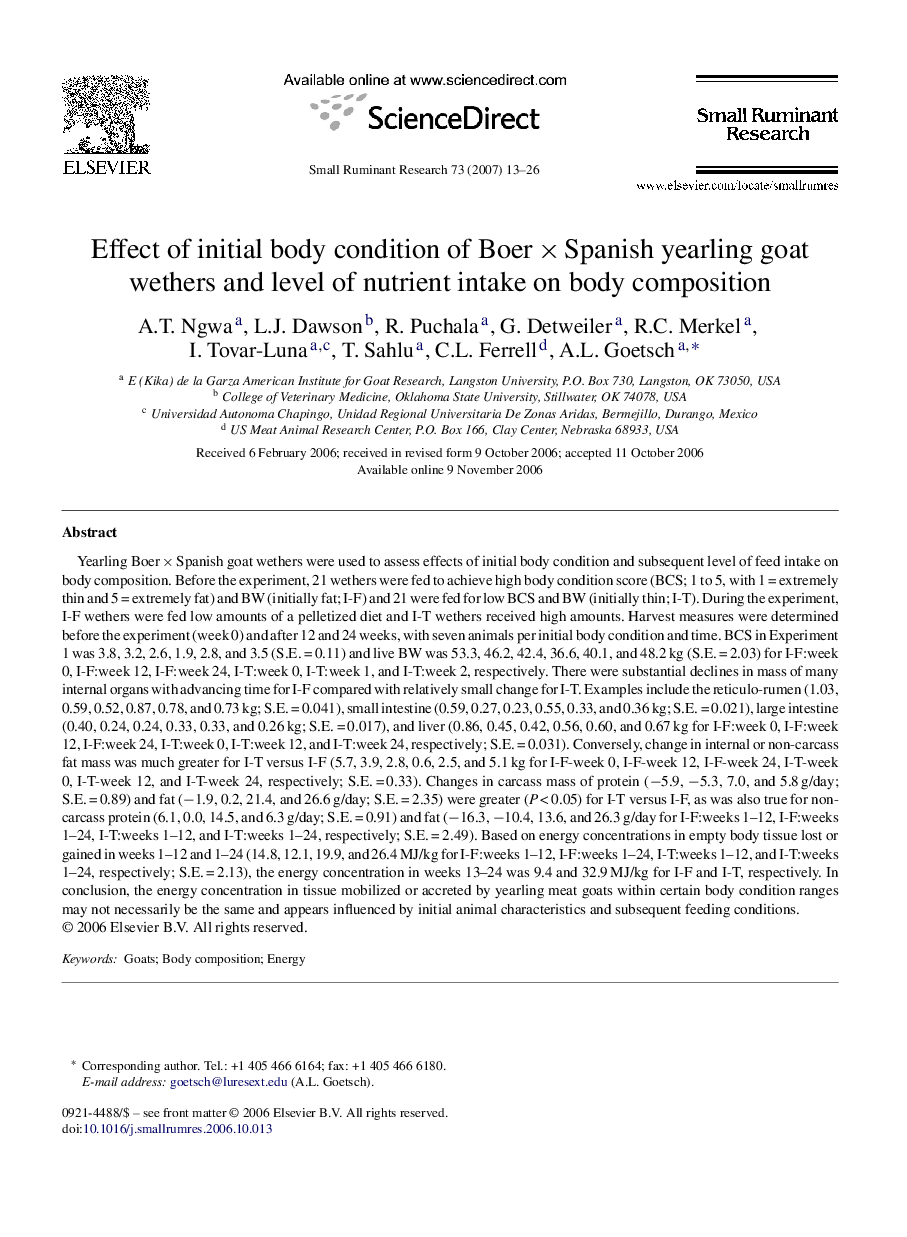| Article ID | Journal | Published Year | Pages | File Type |
|---|---|---|---|---|
| 2458055 | Small Ruminant Research | 2007 | 14 Pages |
Abstract
Yearling Boer Ã Spanish goat wethers were used to assess effects of initial body condition and subsequent level of feed intake on body composition. Before the experiment, 21 wethers were fed to achieve high body condition score (BCS; 1 to 5, with 1 = extremely thin and 5 = extremely fat) and BW (initially fat; I-F) and 21 were fed for low BCS and BW (initially thin; I-T). During the experiment, I-F wethers were fed low amounts of a pelletized diet and I-T wethers received high amounts. Harvest measures were determined before the experiment (week 0) and after 12 and 24 weeks, with seven animals per initial body condition and time. BCS in Experiment 1 was 3.8, 3.2, 2.6, 1.9, 2.8, and 3.5 (S.E. = 0.11) and live BW was 53.3, 46.2, 42.4, 36.6, 40.1, and 48.2 kg (S.E. = 2.03) for I-F:week 0, I-F:week 12, I-F:week 24, I-T:week 0, I-T:week 1, and I-T:week 2, respectively. There were substantial declines in mass of many internal organs with advancing time for I-F compared with relatively small change for I-T. Examples include the reticulo-rumen (1.03, 0.59, 0.52, 0.87, 0.78, and 0.73 kg; S.E. = 0.041), small intestine (0.59, 0.27, 0.23, 0.55, 0.33, and 0.36 kg; S.E. = 0.021), large intestine (0.40, 0.24, 0.24, 0.33, 0.33, and 0.26 kg; S.E. = 0.017), and liver (0.86, 0.45, 0.42, 0.56, 0.60, and 0.67 kg for I-F:week 0, I-F:week 12, I-F:week 24, I-T:week 0, I-T:week 12, and I-T:week 24, respectively; S.E. = 0.031). Conversely, change in internal or non-carcass fat mass was much greater for I-T versus I-F (5.7, 3.9, 2.8, 0.6, 2.5, and 5.1 kg for I-F-week 0, I-F-week 12, I-F-week 24, I-T-week 0, I-T-week 12, and I-T-week 24, respectively; S.E. = 0.33). Changes in carcass mass of protein (â5.9, â5.3, 7.0, and 5.8 g/day; S.E. = 0.89) and fat (â1.9, 0.2, 21.4, and 26.6 g/day; S.E. = 2.35) were greater (P < 0.05) for I-T versus I-F, as was also true for non-carcass protein (6.1, 0.0, 14.5, and 6.3 g/day; S.E. = 0.91) and fat (â16.3, â10.4, 13.6, and 26.3 g/day for I-F:weeks 1-12, I-F:weeks 1-24, I-T:weeks 1-12, and I-T:weeks 1-24, respectively; S.E. = 2.49). Based on energy concentrations in empty body tissue lost or gained in weeks 1-12 and 1-24 (14.8, 12.1, 19.9, and 26.4 MJ/kg for I-F:weeks 1-12, I-F:weeks 1-24, I-T:weeks 1-12, and I-T:weeks 1-24, respectively; S.E. = 2.13), the energy concentration in weeks 13-24 was 9.4 and 32.9 MJ/kg for I-F and I-T, respectively. In conclusion, the energy concentration in tissue mobilized or accreted by yearling meat goats within certain body condition ranges may not necessarily be the same and appears influenced by initial animal characteristics and subsequent feeding conditions.
Keywords
Related Topics
Life Sciences
Agricultural and Biological Sciences
Animal Science and Zoology
Authors
A.T. Ngwa, L.J. Dawson, R. Puchala, G. Detweiler, R.C. Merkel, I. Tovar-Luna, T. Sahlu, C.L. Ferrell, A.L. Goetsch,
